
Santa (Aplysia punctata) and us wanted to say thank you for 2024 and happy new year! Image by Bernard Picton, *slightly* modified by Katrine
See you in 2025!

From the 13th to 20th of October, we were on fieldwork again! This time the end destination was Sletvik field station. Sletvik field station belongs to the Norwegian University of Science and Technology in Trondheim (NTNU). The team of NorDigBryo (digitization of Norwegian Bryozoa) had organized a workshop there and team snail was invited to tag along for the opportunity to collect some snails around the area. So there the three of us traveled from Bergen up North; Jon and Katrine for the Bryozoan workshop and me for the Lower Heterobranchia and Pyramidellidae project.
The travel from Bergen to Trondheim takes more than 10 hours! For such a long travel we of course needed to take several breaks throughout the day. But with a bunch of biologists on the way it was very difficult to not sample during those stops whenever we had the opportunity (1).
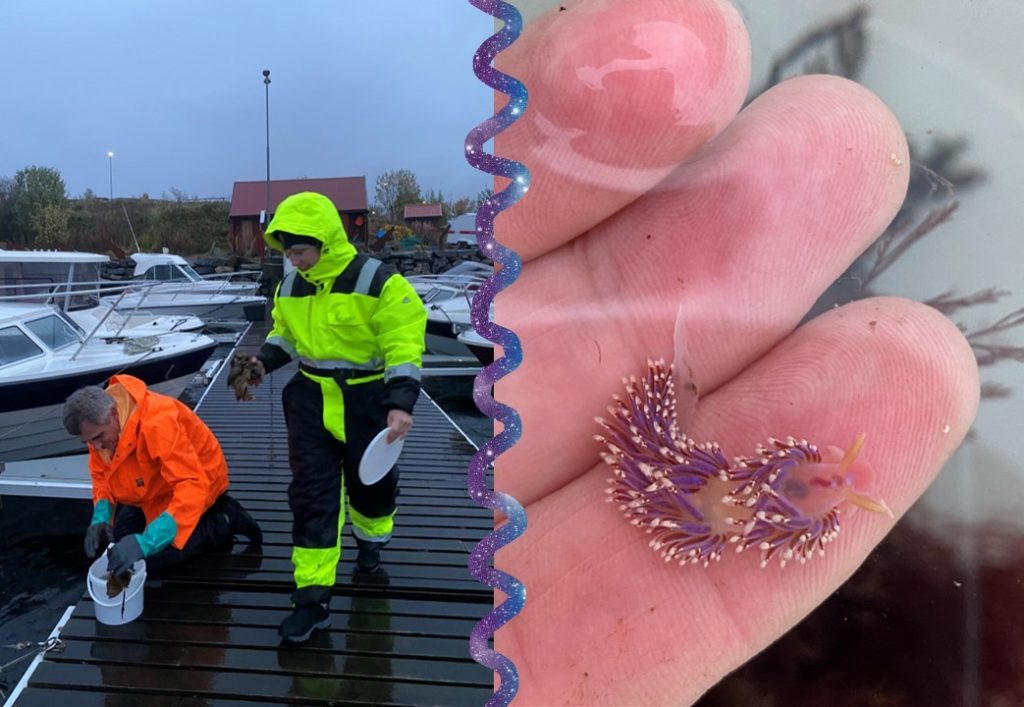
1. Sampling on our way, together with Jon & Katrine visiting several harbors. Photo: Cessa Rauch, UiB.
After a very long day, we finally arrived at our end destination; Sletvik field station. This would be our home for the coming week. The station has great facilities with different laboratories, a cantina with 3 meals a day being served by the kitchen staff and sleeping facilities. There is space for up to 40 students, so with just 10 of us we had a ton of space (2).

2. The Sletvik field station from the Norwegian University of Science and Technology in Trondheim (NTNU). Photo: Cessa Rauch, UiB.
The Sletvik field station is located on the small peninsula called Slettvik; surrounded by mostly water makes it an excellent location for marine related fieldwork. Despite the relatively small size of the peninsula, it has a surprising number of different habitats; there are seagrass meadows, sea bottoms covered in encrusting coralline algae and due to strong tidal currents, a very vibrant and diverse marine life (3).
Therefore, we used several days that week to collect fresh material from around the area: by using nets or hands either from land or while in the water snorkeling (4).

4. Snorkeling for samples in strong tidal current right under the little bridge, with Jon and Cessa. Photo Katrine Kongshavn, UiB.
The strong tidal currents are what a lot of the Pyramidellid species absolutely love! Not the least because it attracts high diversity of their hosts that they parasite on (5). Places with lot of current have large influx of nutrients and are well oxygenated which often results in high diversity, such as the well-known Saltstraumen area in Nordland. Therefore, it was easy to collect them as the snails were so abundant.

5. Hard to spot the small snails, here Odostomia turrita (blue circle) crawling away from its host Serpullid worm (white with blue fringes). Photo: Cessa Rauch, UiB.
But it became clear quickly that a few species were quite dominant. The four most common Pyramidellid species in the shallow tidal currents around Sletvik were Odostomia turrita; Brachystomia scalaris; Spiralina spiralis and Parthenina intersincta (6). Although Pyramidellidae snails are often very difficult to identify, these fours exhibited very typical characteristics which made it somewhat easy to name them to species level (7).

6. 4 of the most common species found in Sletvik: Left up; Odostomia turrita, left down; Brachystomia scalaris, right up; Spiralina spiralis, right down; Parthenina intersincta. Photo: Cessa Rauch, UiB
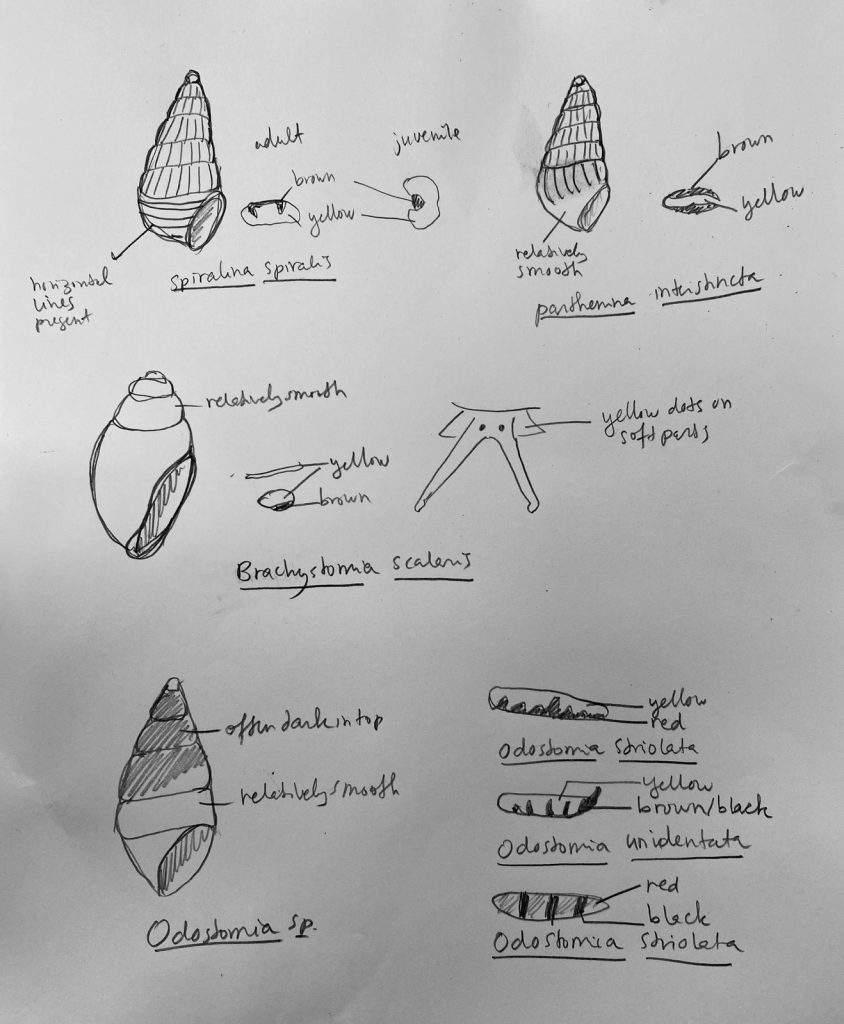
7. Doodles of the most recognizable characters of different common species in Sletvik. Photo: Cessa Rauch, UiB.
However, we still will extract DNA from these animals to confirm species, as it still can happen that we are having snails that are very similar and might have been misidentified in the field. That is why it is important to fix the collected snails in ethanol, so the tissue and DNA in it stays preserved. All collected material will then go back to the University Museum of Bergen to be further used for microscopy, morphological analysis, DNA extractions and eventually become part of the collection of the museum.
After one week, with hours of sorting through collected material, we managed to collect and identify 15 different species; the most so far of any fieldwork so we can say that Sletvik is truly a snail heaven!
– Cessa
Don’t miss out in the coming exhibition at the University Museum!
Jellyfish unveiled will be open 4.-30. October
at Muséplassen 3 in Bergen (link)
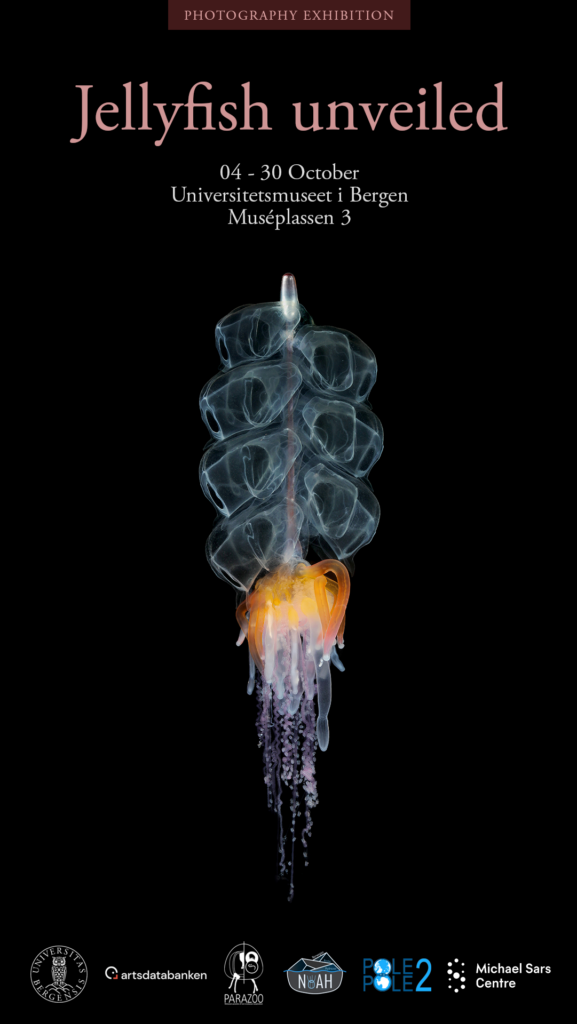 Feared and misunderstood, jellyfish are often dismissed as little more than ocean pests. Over 100 species of jellies live in Norwegian waters, but most people are unaware of the delicate balance they bring to marine ecosystems. Which roles do they play? Why should we care about them?
Feared and misunderstood, jellyfish are often dismissed as little more than ocean pests. Over 100 species of jellies live in Norwegian waters, but most people are unaware of the delicate balance they bring to marine ecosystems. Which roles do they play? Why should we care about them?
The exhibition Jellyfish unveiled, created by the “Manet Team” at the Department of Natural History and the Michael Sars Centre at the University of Bergen, invites you to explore new perspectives on jellyfish and the impact they have on the ocean. Changing the way we think about jellyfish can be challenging, but these images offer a unique glimpse into the positive aspects of their lives and the crucial contribution they make to our waters.
Make sure to visit, it opens on October 4th!
After the Summer break the hunt for small snails continues. This time the museum staff got invited by Vivian Husa from the Institute of Marine Research and Erling Svensen underwater photographer and author of Marine fish & invertebrates of Northern Europe to come and help with marine biodiversity assessment in Egersund.
Egersund is a small village at the southwest side of Norway and strangely has almost no difference in height between low and high tide. The tidal range is close to zero due to the presence of a tidal node, which there are several off around the globe. This all makes Egersund a very interesting place to hunt for snails (and other marine organisms)!
Our stay was at a very special place; a lighthouse, called Viberodden (1).
The Viberodden lighthouse is build on a small island 15 minutes’ drive with boat from Egersund city center. Today it is run by the so-called Viberodden friends’ foundation (Viberodden venner). They rent out the lighthouse to be able to cover the costs for maintenance and cultural activities. The lighthouse was originally built to secure entrance to Egersund in 1855 and has been upgraded several times since. The lighthouse was manned until 1977, when it became fully automatic. In 2007 the Viberdden friends’ foundation rehabilitated the entire lighthouse, and they are still in charge of upkeeping today. We therefore also want to thank the foundation for the hospitality and the possibility for us to use the lighthouse as a research station for the week!
Once we arrived in Egersund, Erling would be waiting for us with his boat to drive us and a whole lot of equipment to the lighthouse (2).
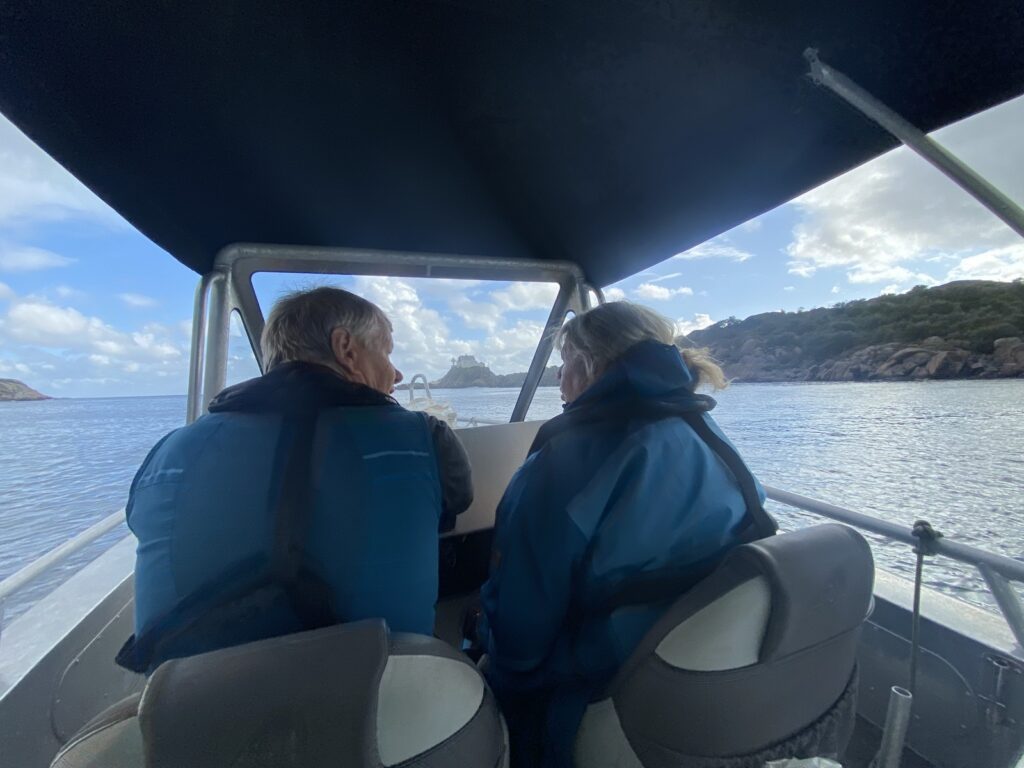
(2) Erling Svensen (left) and Vivian Husa (right) organizers of the workshop on their way to the lighthouse. Photo Cessa Rauch, UiB.
During the week, we grew in number of participants and eventually the team existed of a mix of researchers from different institutions and companies with a variety of backgrounds. We had with us macroalgae, Bryozoan (moss animal), Ascidian (sea squirts), sea slug specialists and more (3).
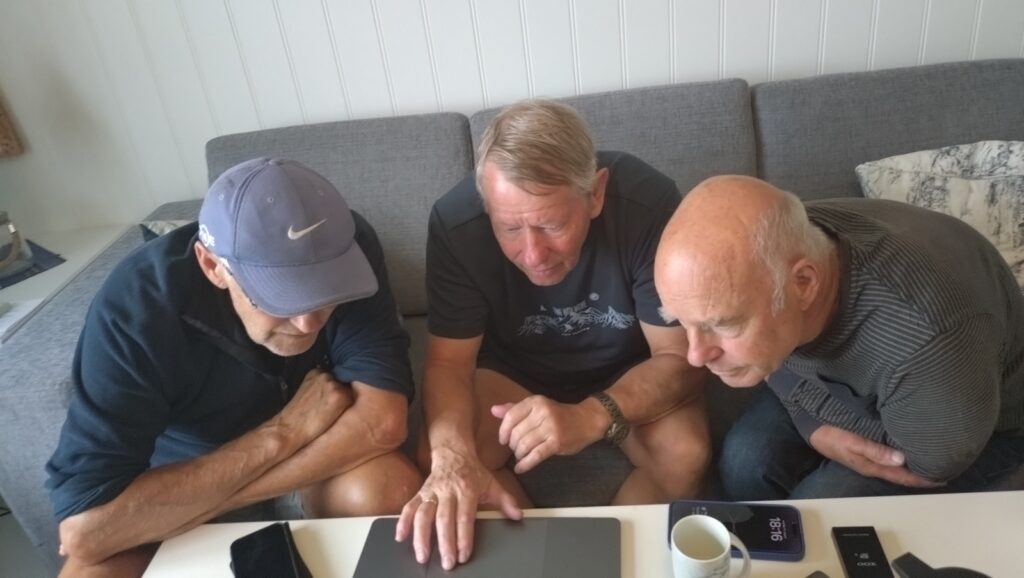
(3) From left to right Bjørn Gulliksen professor emeritus from the Norwegian Arctic University, Erling Svensen and Bernard Picton curator of marine invertebrates, National Museums Northern Ireland, together in discussion. Photo Katrine Kongshavn, UiB.
From the museum we were also representatives of several different Norwegian taxonomy initiatives (artsprosjektet). There was “Digitization of Norwegian Bryozoans” (NorDigBryo), “Marine Amphipods: Diversity, Species Complex, and Molecular Studies” (MADAM) and of course “Lower Heterobranchia and Pyramidellidae of Norway”.
During the week we would collect several different habitats, from exposed kelp forests to blue mussel beds in the Egersund harbour. The lighthouse itself was built far out and therefore very exposed hence we were dependent on the weather for us to go out and collect. Luckily, we had a few good weather days that allowed us to snorkel while collecting samples (4).
To get our specimens we collected different habitats by using jars, nets and buckets and amazingly all our samples turned out to be rich in species (5 & 6).
While searching for snails there was a clear preference of certain species to inhabit either exposed or sheltered environments, kelp or sandy bottoms. In one case we had to brush a lot of blue mussels to get to the Pyramidellidae (Odostomia turrita) that parasite on them and on the worms (Serpulidae) that grow their houses on the outside of the blue mussel shells (7).
But we also found certain species that crawled around in the mud (8) and others that were on the kelp (9).
The days were long, and we had to do a lot of sorting of the many materials that were collected (10).
But it was very much worth it as we found a range of interesting species that we did not collect in earlier fieldtrips from this year (11 & 12).
All these new findings and collection building would not have been possible without the help of the organizers, participants and the possibility for us to stay at the Viberodden lighthouse and therefore we would like to thank Erling Svensen, Vivian Husa, Bernard Picton, Mette Eilertsen, Bjørn Gulliksen and Viberodden friends’ foundation! Thank you for a great and productive week!
-Cessa
Have you ever heard about chaetognaths, aka arrow worms? They are a phylum of worm-like animals mostly found as part of planktonic communities worldwide. Their name originates from chaeto (spines) and gnatha (jaws). As you can see in the picture below, their name refers to their hooked, grasping spines located on each side of their head. Chaetognaths use their spines to grasp their prey (sometimes other arrow worms!). Luckily for us, they are just a few cm long, up to 10-12 cm in some cases, so nothing to worry much about. They can also have a funny, Edvard Munch’s The Scream’s-like appearance, such as the benthic chaetognath below. With over 130 species described worldwide, our knowledge on their true diversity and distribution is still very scarce. What we do know is that they are one of the most important planktonic predators and the second-most abundant planktonic group. Most species are transparent, and often classified as part of the so-called gelatinous zooplankton. However, ca. 20% of the species are benthic chaetognaths that can be found close to the seabed (like the surprised guy below).
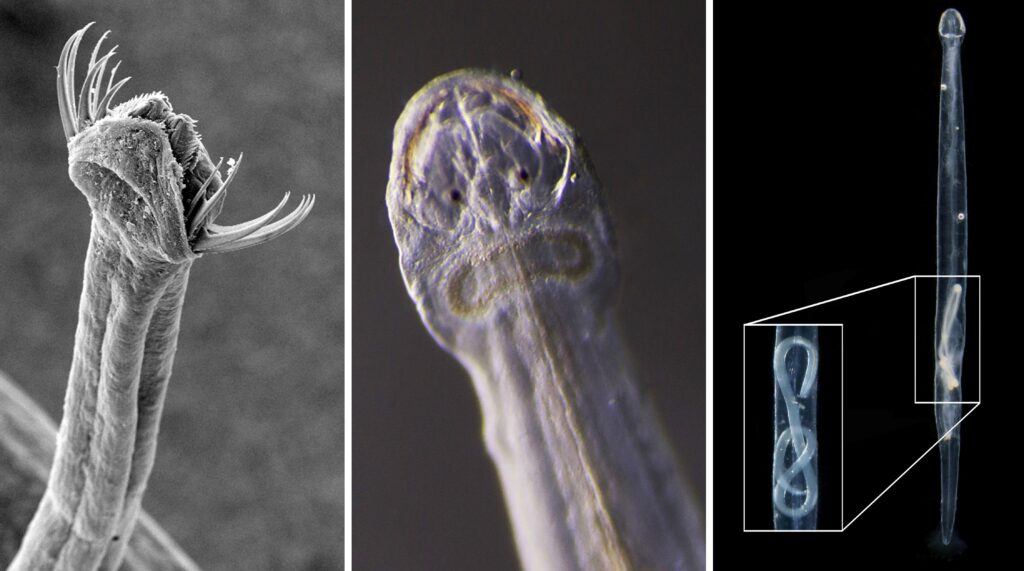
Figure 1. Different appearances of arrow worms, the one on the right with a parasitic nematode. Credit: Zatelmar CC BY SA 3.0 (left), Luis Martell (middle) and Luis Martell and Joan J. Soto-Angel (right).
Through Artsdatabanken project ParaZoo (Metazoan Parasites of non-crustacean Zooplankton) we are studying the diversity of parasites associated with jellyfish, comb jellies and chaetognaths. As we found very interesting specimens from our sampling trips to Svalbard, we joined a recent trip to Torsvåg in Northern Norway, hoping to get additional material from this understudied area. You can read more about this joint fieldwork here and here. Our MSc student Lea will tell you a bit more about her MSc project, and her experience in Torsvåg.
From Lea:
Hei! I am Lea, a Master student working on my Master thesis about the last C in the C + C + C research group: Cnidaria, Ctenophora, and now Chaetognaths! I am working with parasites of chaetognaths in Norwegian waters, a still much understudied topic. On the sampling trip to Torsvåg in Northern Norway, I got first hand experiences with a variety of sampling methods, cool jellies, and getting to know everyone better from the marine team at the University Museum.Among the sampling methods, my favourite was definitely catching the jellies with a small net on the pier (see Figure 2). There, we – fearless of the everchanging weather conditions – caught the biggest jellies of our trip. Afterwards, I was mainly in charge of checking jellies for parasites for the ParaZoo, where we found trematoda in 2 different jelly species!
Sadly, pelagic chaetognaths were very sparse in Torsvåg. We even deployed manually (!) a plankton net all the way to 200 m deep in search for chaetognaths, but we only found about 30 in total, that were also unparasitized. Luckily, the polychaete group next door could offer some comfort.
Let me introduce you to my absolute favourite species from the trip: The benthic chaetognath Spadella cephaloptera! Have a bad day? – Just take a look at the constantly surprised, concerned, and slightly uncanny face of this small fella! You can count on me overusing this species in my upcoming presentations!
All in all, I developed a lot of useful skills, ranging from identifying common (and uncommon) gelatinous zooplankton species to untangling a fishing rope! It was such an amazing experience to be part of this sampling trip!
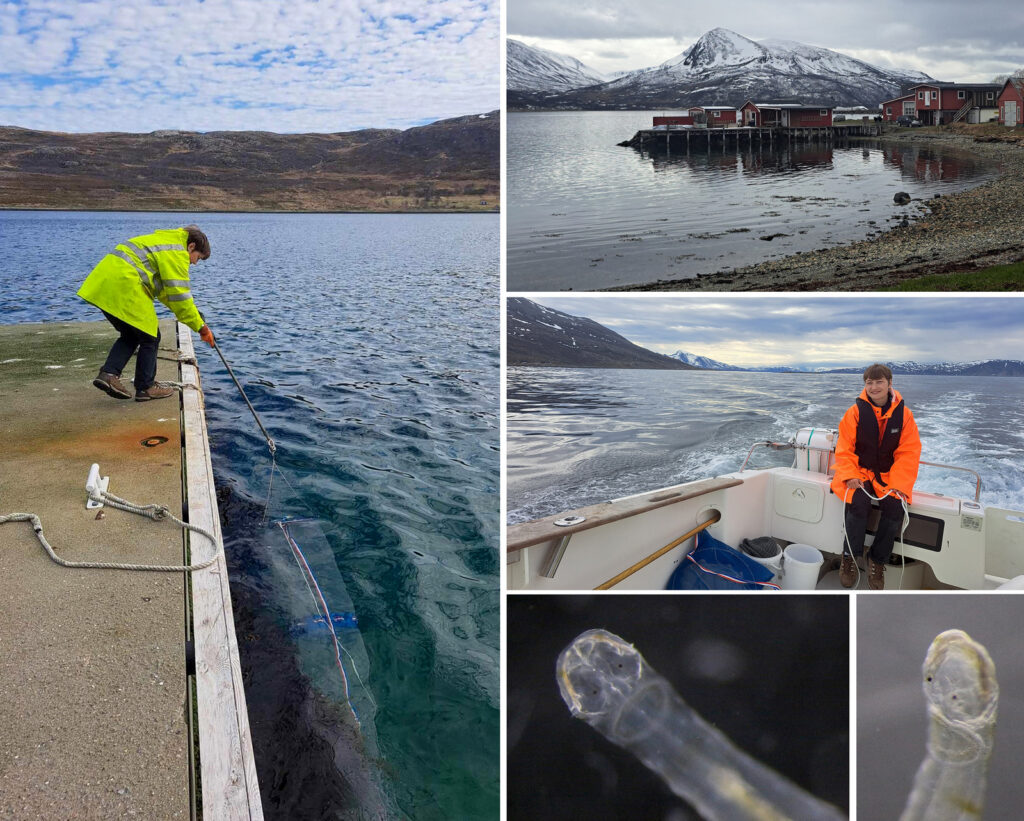
Figure 2. Net sampling from different locations in beautiful Torsvåg. Spadella cephaloptera looking constantly surprised due to the corona ciliata below the two eye pigments (Photos: Joan J. Soto-Angel and Lea Dober)
From Joan and Lea
In the last week of June, the MAnDAriN project (Marine Annelid Diversity of Arctic Norway, homepage here) went for another* field trip to the areas around Tromsø.
This time we were focused on intertidal sampling in the inner fjords.
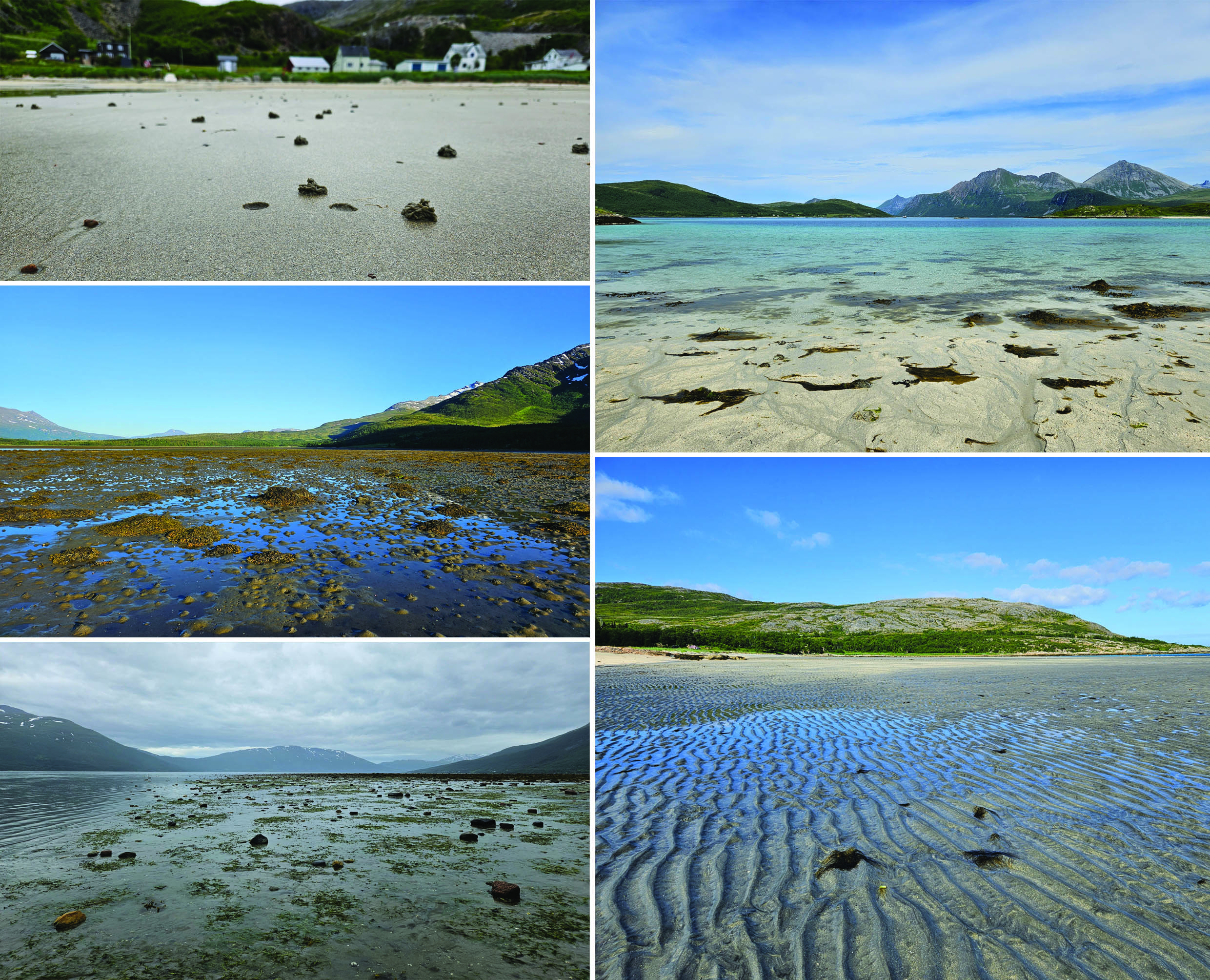
Figure 1. Different habitats sampled during the second field trip of MAnDAriN to Tromsø area (Photo by N. Budaeva).
Besides Nataliya and Tom, the sampling team included a dedicated young naturalist interested in digging up worms on the mudflats and watching for seabirds.
Two researchers from NIVA, Eivind Oug and Rita Næss, joined us for the part of the trip helping with selecting the most interesting habitats and with sample collection. We sampled 18 intertidal and shallow subtidal stations scattered around Tromsø area, among those some beaches at Sommarøy, eelgrass mudflats in the inner Balsfjorden, sandy Grøtfjorden, and muddy habitats of Kvaløy.
The sampling was qualitative with light fraction of sediment sieved through 500 um sieve and later sorted in the lab under a stereomicroscope. We invested a lot of time in taking live images of the small polychaetes found in the samples, for that we had to relax them in a magnesium chloride solution that stops muscle contraction but keeps the worms alive. App. 900 photos of 400 specimens was taken during this trip. Each of the photographed specimens will become a DNA voucher for further barcoding and molecular analysis.
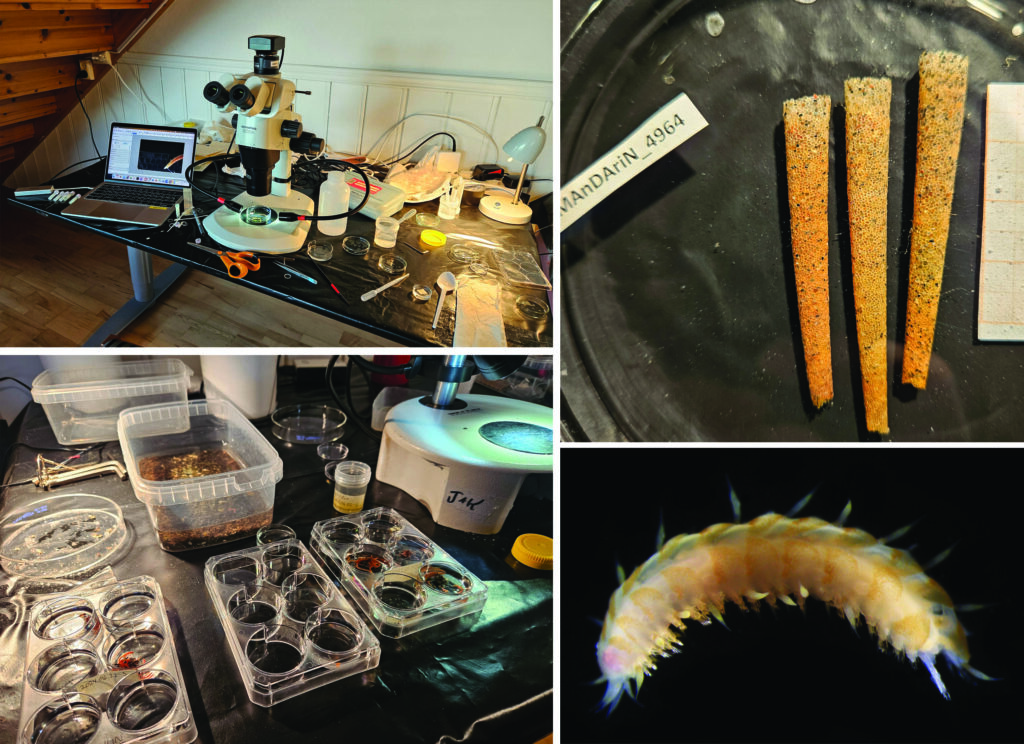
Figure 3. Our laboratory set0up with photography equipment. The worms on the top right – tubes of Lagis koreni, and the bottom right – Malmgrenia sp.
MAnDAriN is supported by Artsdatabanken for 2023-2026 and will continue sampling in Svalbard and northern Finnmark fjords this and next year to provide a detailed description of annelid diversity in the coldest Norwegian waters.
*Eva, a master student on the project, has written about her experience joining the previous project fieldwork in Torsvåg (Troms) in May, you can read more about that here (link):
Fresh off the press:
“Diversity of Orbiniella (Orbiniidae, Annelida) in the North Atlantic and the Arctic“,
published in ZooKeys. DOI: 10.3897/zookeys.1205.120300 (link goes to paper, it is Open Access)
In this recent publication, PhD candidate Miguel and his co-authors present three new species of marine bristle worms (polychaeta) in the family Orbiniidae, all from the genus Orbiniella.
The work focused on studying the diversity of the group from the North Atlantic and the Arctic, and has used a combination of molecular and morphological analyses.
The new species have been named Orbiniella parapari, Orbiniella griegi, and Orbiniella mayhemi. The choice of names (etymology) goes as follows:
This may the first time classical composer Edvard Grieg and infamous black metal band Mayhem are presented as closely related?

Figure 7 from the paper, showing details of Orbiniella mayhemi Meca & Budaeva, sp. nov. Image credit: Miguel A. Meca et al. 2024, CC BY 4.0
Citation: Meca MA, Kongsrud JA, Kongshavn K, Alvestad T, Meißner K, Budaeva N (2024) Diversity of Orbiniella (Orbiniidae, Annelida) in the North Atlantic and the Arctic. ZooKeys 1205: 51–88. https://doi.org/10.3897/zookeys.1205.120300 (link)
From 21 till 28th of May, researchers, technicians, and students of the University Museum’s marine section, travelled up North to Torsvåg, close to Tromsø, for joint fieldwork. The participants represented several Artsdatabanken projects that cover marine fungi, hydrozoans, polychaetes, parasites of jellyfish, comb jellies and chaetognaths, bryozoans, marine amphipods and finally the Lower Heterobranchia and Pyramidellidae gastropods. In this blog you can read about the general experience of the fieldwork and more details about the different projects. And here you can read about the fieldwork through the eyes of two master students who joined. And if you want to read more adventures and see more pictures check out this blog post! It was a large group of young and more experienced scientists which created the perfect opportunity for a lot of knowledge transfer.
This was also the first “big” fieldwork trip for the Lower Heterobranchia and Pyramidellidae project, after several sampling events in the Bergen area, which you can read here. Both Lower Heterobranchia and Pyramidellidae include small snails, just a few millimetres in length that are hard to identify (they can resemble other small species of gastropods). The diversity of these tiny sea snails is poorly understood in Norway, and thus, during this project these sea snails will be studied by combining DNA barcoding and shell characters. Sampling will be based on the use of dredges, grabs, and snorkelling.
Pyramidellidae are regarded as ectoparasites and are often found living on other molluscs or other marine invertebrates, but also free in soft sediments. The Lower Heterobranchia are often found on algae, for example on the stipes and in between the holdfasts of large kelp. Because of the small size of these snails the best way to collect them is by sampling the substrate they live on. So, this is what we did, we went snorkelling several times in the cold waters of Northern Norway, but thanks to good neoprene layers we were able to keep warm and simultaneously looking like seals!
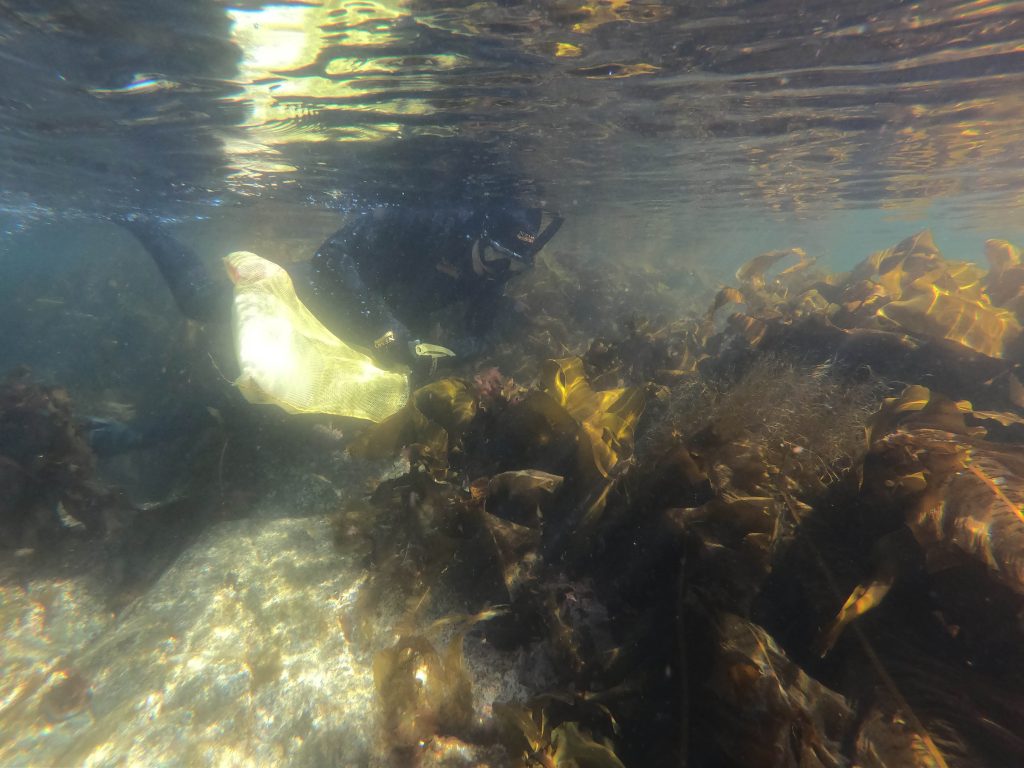
Collecting the right substrates for the Lower Heterobranchs and Pyramidellidae while snorkeling. Photo by Eva Charlotte Samson, UiB
It was challenging to find our snails; there was plenty of kelp and high diversity of many other taxonomic groups, but the conditions were not exactly right especially for the pyramidellids that seem to prefer areas with strong currents.
So, even though we sampled many different habitats, we often ended up not finding our snails when back in the lab sorting under the microscope.
Yet, after collecting a ton of material and spending many hours sorting, we finally found one pyramidellid!
In this case Odostomia turrita.
Odostomia are neat little pyramidellids that have glands with distinct colours, which makes somewhat easier the identification of species.
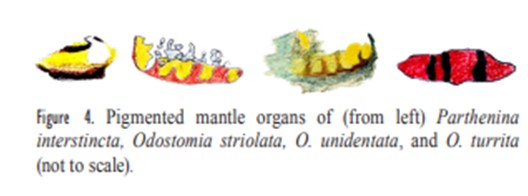
The different colour patterns distinguish different Odostomia species. Source from Høisæter 2014. (Høisæter, T. (2014). The Pyramidellidae (Gastropoda, Heterobranchia) of Norway and adjacent waters. A taxonomic review).
Although minute, the lower heterobranch were “easier” to find… They seem to be less picky with the environment, and on kelp and sand we managed to sample a few different species, amongst others two very similar ones: Ammonicera rota and Omalogyra atomus. In addition, we found in the sand and gravel small snails of the genus Rissoella – R. globularis.
Field season has just started, this was a good beginning for a busy Summer with many more blogs to come!
-Cessa & Manuel
A couple of weeks ago, a team of five jellyfish and polyp enthusiasts travelled to Torsvåg, Vannøya, a beautiful location two hours north of Tromsø by car (more about the fieldwork can be found here). Our goal? Collect, identify and catalogue some little-known hydrozoans for Artsdatabanken project NOAH (Norwegian Arctic Hydrozoa). This is the 3rd dedicated NOAH trip to obtain Arctic samples (or examine collections) in the last 12 months! After a very successful Arctic expedition to the West and North of Svalbard on board Kronprins Haakon in the context of the Barents Sea Ecosystem Survey by IMR, and a 1-week workshop at the Institute of Oceanology Polish Academy of Sciences (IOPAN) co-organized by our colleague Marta Ronowicz, this time we focused on the underexplored coasts of northern Norway.
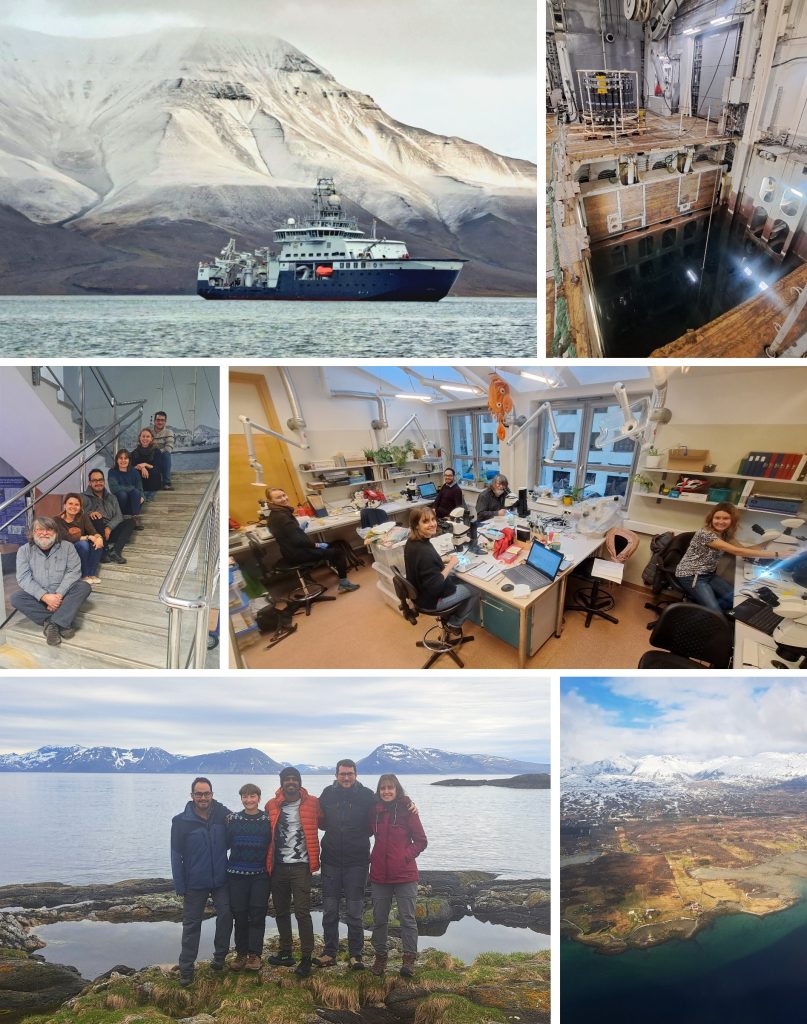
Recent NOAH-related sampling trips. On top, Barents Sea Ecosystem Survey by IMR on board icebreaker Kronprins Haakon; in the middle, at IOPAN examining Marta Ronowicz’s extensive collection; bottom, NOAH team in Torsvåg (Troms). Pics: Joan Soto, Piotr Bałazy, Robert Johansen
Cruises, especially on cutting-edge icebreakers crashing ice on their way to the poles, are a lot of fun, but getting deep-water samples of both jellyfish and polyps is all but easy. Consequently, even when we carefully optimize the sampling procedures, some fragile species often arrive damaged or in bad shape. This time, we collected shallow-water specimens using our own hands. In addition to (MANUAL!) net deployments at ca. 180 m depth, we intensively checked marinas, tide pools, and shallow infralittoral environments by snorkeling. It worked fantastically well for those picky jellies and polyps which tentacles/polyps get lost after being trawled or towed with a tone of hard-bodied invertebrates and slimy fish within massive nets. We took the opportunity to document them in detail using both microscopes and macro photography. During our trip, we had the visit of Stine and Linda from Artsdatabanken. They even kindly gave us a hand collecting jellyfish from the piers! Good catch!
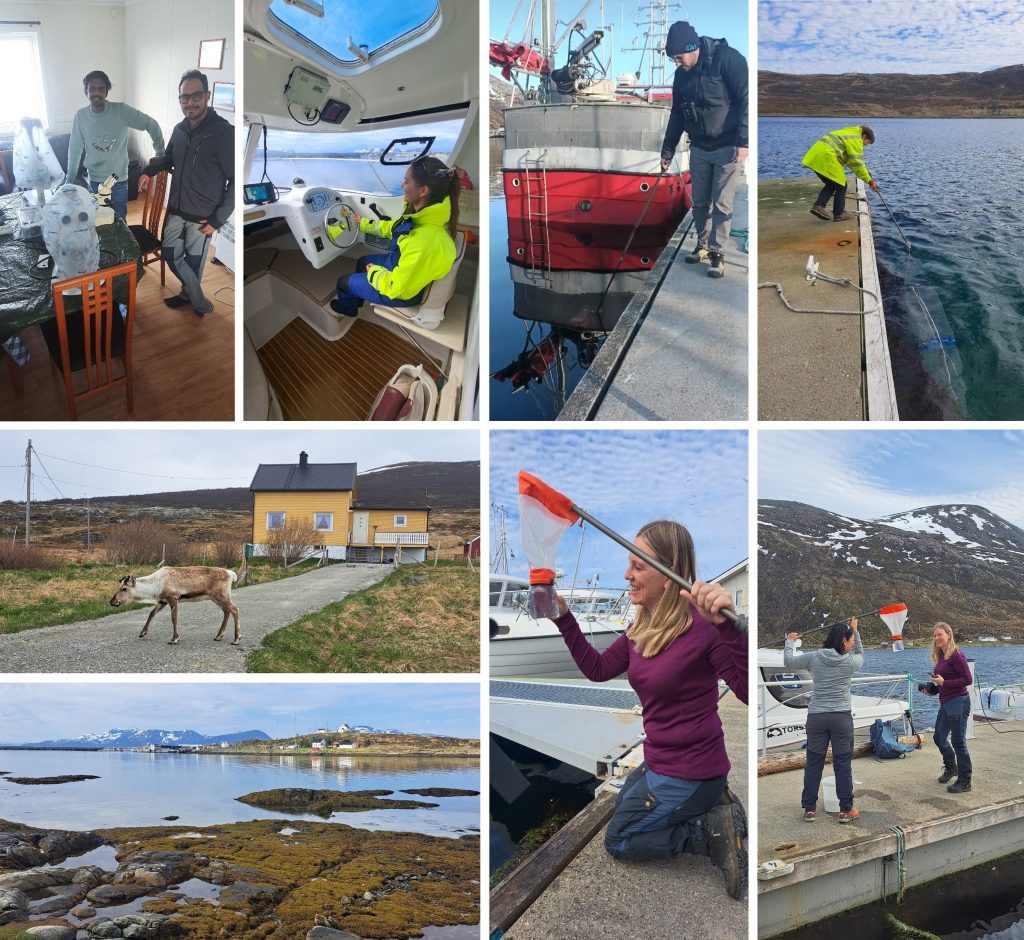
Wide array of sampling methods, landscapes and local fauna, including a brand new wet lab (before: living room) specially made for the occasion. Stine and Linda testing our hand nets and successfully collecting some jellies. Pics: Joan Soto, Praveen Raj.
Each of us had our favorite species and top findings for the trip, and we were really excited to see alive and in good shape those species we have only examined within preserved collections, or only read about in scientific publications. These findings will definitely contribute to a better knowledge on the true diversity and distribution of these little known species, some of which have rarely been reported that far north in continental Norway.
I (Joan) stop here and leave you with some insights from the other NOAH team members that joined the trip: Marta and Praveen.
From Marta:
This was such a very interesting experience! During my work I usually study deep ecosystems, so I do not often see fresh samples of benthic hydroids, and when I do, they are often damaged by the sampling gear (e.g. bottom trawl, beam trawl…). This trip to Torsvåg has allowed me to sample the intertidal pools and marinas with my own hands, discover the great diversity that exists just below the surface, and to see multiple species in a way I never seen before.
For me, the most interesting species were undoubtedly the athecate hydroids, such as the incredibly beautiful Zanclea spp. and Sarsia spp. These animals are extremely fragile due to the lack of a theca to protect the polyp. In Torsvåg, I saw athecate hydroids of extraordinary quality, studied their sexual structures, their morphology, colours, behaviour… Simply: WOW!!! I’m very much looking forward to the next NOAH trip!
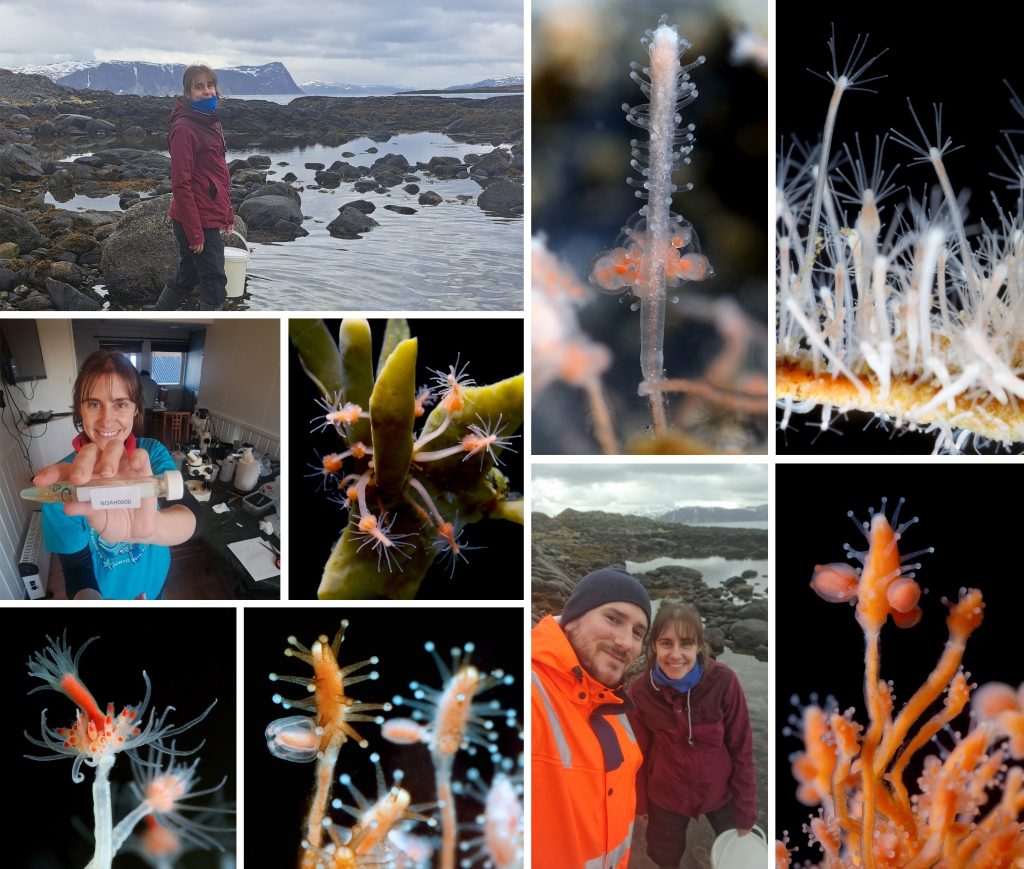
During our sampling trip, Marta Gil (visiting researcher) showed a lot of excitement about the diversity in the intertidal pools and collected beautiful athecate polyps, all with reproductive structures! Pics: Joan Soto.
From Praveen:
My first sampling trip after joining the Cnidaria and Ctenophora Team as a PhD student was nothing short of exhilarating. Our team, led by Joan Soto, was focused on various life stages and projects related to the phyla Cnidaria and Ctenophora. Although I had conducted similar sampling procedures in India, working with live specimens of both planktonic and benthic stages of Cnidarians in Torsvåg was a new and fascinating experience.
One of the trip’s most challenging parts was venturing into open waters with a small fishing boat to collect samples. We had to troubleshoot a bit on board, but it finally turned out to be a success. Despite not finding Dimophyes arctica, one of the target species for my PhD, I was captivated by the immense diversity of hydroids in the piers near the island, some of which might be the so-far unknown polyp stage of some known Norwegian hydromedusae. Special thanks to Luis and Marta, who taught me a lot about hydrozoan taxonomy, and Cessa and Jon for driving the boat and patiently wait for the net to be recovered.
The research was undoubtedly the focus, but the social activities and adventures we shared were equally memorable. Torsvåg itself was mesmerizing, with its high mountains and breathtaking views. We all enjoyed evening hikes and took advantage of the midnight sun, which provided a perfect balance to our intense sampling schedule. Our group dinners were another highlight of the trip for me: with colleagues from 7 different nationalities and 3 continents, we had a delightful variety of cuisines as we took turns for preparing dinner.
All in all, this sampling trip was an incredible blend of scientific discovery and personal enrichment. The stunning landscape and the camaraderie of our team made it an unforgettable experience.
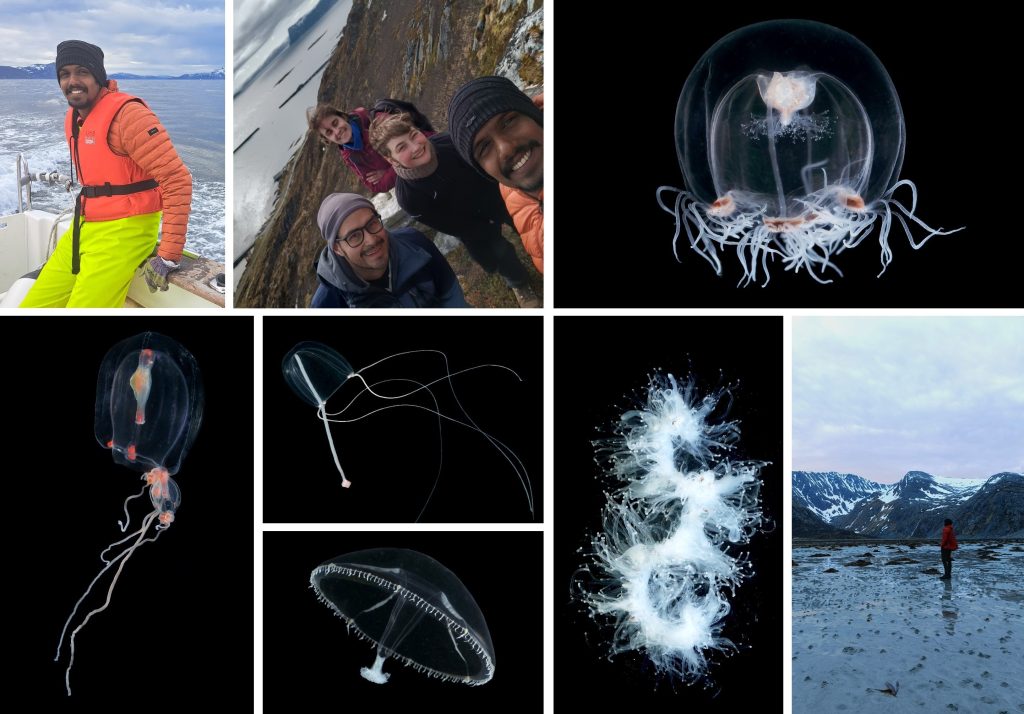
Praveen Raj on his first sampling trip for his PhD. He not only captured and identified an impressive amount of jellyfish, but also had a great time hiking around Torsvåg and enjoyed the dramatic landscapes that Northern Norway can offer. Pics: Joan Soto, Praveen Raj, Lea Dober.
From Joan, Marta and Praveen.
“Ooh ooh ooh! I found a parasite! Bonita!”
– A phrase not usually heard in the fishing harbor of Torsvåg! But this week was far from the usual fishing business.
Heisann!
We are Eva and Lea, and we’re marine biology students in the second semester of our masters degree.
Since we’re writing our master’s theses at the University Museum, we got to be a part of the fieldwork in Torsvåg (Troms) in the last week of May.
Welcome to our first sampling trip with the researchers from the University Museum of Bergen and the University of Tromsø!
As the trip was a joint project by different groups that work on different phyla, we got opportunities to try a lot of different sampling methods.
Here is a couple of our favorites:
Following the sampling we also spent quite some hours processing the samples and taking pictures in the lab. I (Eva) had my own little workspace where I usually helped with sorting the benthic samples, mostly focusing on annelids as I’m also working on these in my thesis. At the beginning of the week I was struggling to even find worms in between all the sandgrains. But luckily I had a lot of experts sitting in the same room and helping me! And little by little, I got more confident in identifying the common families of polychaetes.
And I (Lea) worked in the gelatinous zooplankton lab, right next to the polychaete group. There, I helped with sorting zooplankton, checking the jellies for parasites, and taking pictures of the specimens. A great opportunity to get to know more about the fascinating diversity of jellies in Norway!
At the end of the long days, we usually fell right into bed and even the midnight sun couldn’t keep us from falling asleep within minutes!
Not only the life underwater had a lot to offer, but we were also astonished at the spectacular wildlife above the surface. Otters, reindeer, all sorts of arctic birds, you name it…
All in all an incredible week for us master students to learn all the field methods and work on living specimens – quite different from the fixed material in the Museum collection. And a great opportunity to get to know everybody from the marine invertebrate groups better!
Lea & Eva